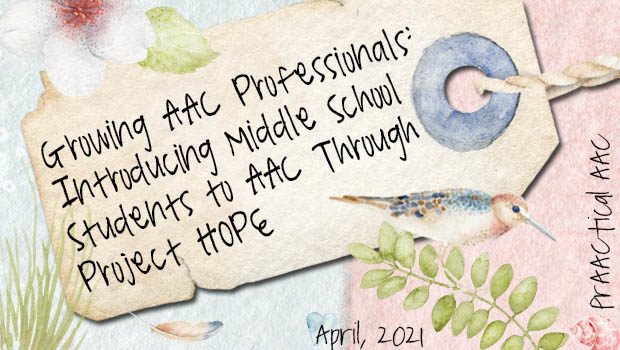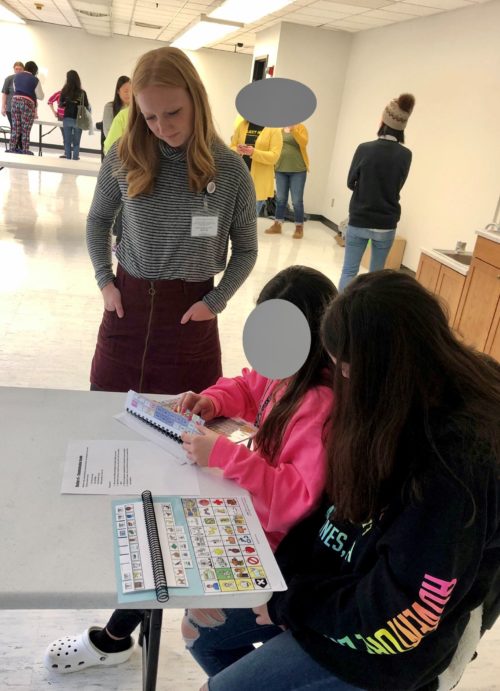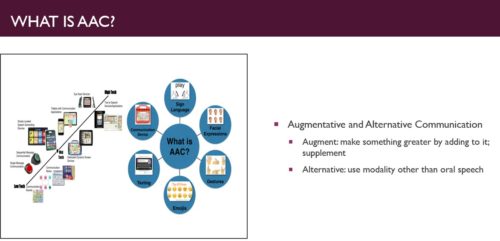Growing AAC Professionals: Introducing Middle School Students to AAC Through Project HOPE

It’s never too soon to introduce people to AAC. Clinical Associate Professor and SLP Krista Davidson, a strong advocate for AAC, is back to share more about the training of pre-professionals. In today’s post, you’ll hear about the way the Communication Sciences and Disorders program at the University of Iowa faculty and graduate students introduce middle schoolers from the local community to the field of AAC.
–
Growing AAC Professionals: Project HOPE
As I have said in my previous posts, the Department of Communication Sciences and Disorders (CSD) at The University of Iowa uses a team-based approach to clinical education. Each graduate student typically rotates through 6 specialty-based clinical teams, mine being the AAC Team. I am continually looking for a variety of learning opportunities to engage students. This time we connect with Iowa’s College of Education and Project HOPE (Healthcare Occupations Preparation and Exploration). Project HOPE is a STEM (Science, Technology, Engineering, and Math)-based curricular intervention that integrates academic and vocational opportunities designed to connect minority and low socioeconomic middle school students to the health science professions early in their education. HOPE addresses the critical national need to increase diversity in the American healthcare workforce. Knowing speech-language pathology is not a racially and ethnically diverse field, I think participation in this program is especially important. I also feel hands-on experiences in AAC are fun and engaging for middle school students (but maybe I’m a bit biased).
When Project HOPE students arrive at the Wendell Johnson Speech and Hearing Clinic, several of our CSD graduate and undergraduate students welcome them. They provide a building tour showing them classrooms, clinic rooms, audiological suites, research labs, the media center (where therapy materials are stored), and the anechoic chamber. Next, the graduate students present a brief overview of the field of speech-language pathology and answer questions. Students from my team create the presentation, and I share one example of their slides here.
Then we transition to a larger classroom space where station activities provide hands-on encounters with a variety of AAC systems. The middle school students are divided into smaller groups to visit each station. There is a CSD student at each table to facilitate interactions between the middle schoolers. The stations contain both low and high-tech AAC equipment (click here to download the materials). The middle school students engage in exploration and programming, and there are discussion questions for each station based on the provided equipment. Our CSD students benefit from the opportunity to educate and engage the next generation of professionals. The middle school students not only get exposure to the field of speech-language pathology and different AAC systems but also gain awareness of what it is like to rely on alternative modes of communication.
Although the current collaboration takes place through a formal program at The University of Iowa, I believe this experience could be modified for undergraduates, visit days, general education classrooms, in-services, or other outreach activities in your local community. It really is a pleasure to watch the interactions that happen when everyone works together to discover the power of AAC. Maybe the next great AAC SLP will find their spark at an event like this one!
Krista Davidson is a clinical associate professor in the Department of Communication Sciences and Disorders at The University of Iowa. She can be reached at krista-davidson@uiowa.edu
Filed under: Featured Posts, PrAACtical Thinking
This post was written by Carole Zangari
